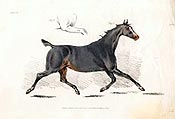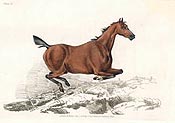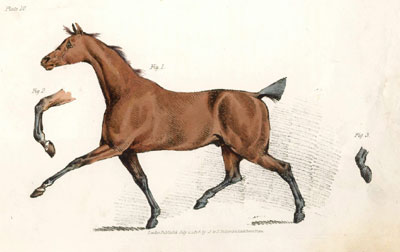|

Grey horse pictures

Composite horse pictures

Bay and chestnut horse pictures
|
Horse Pictures - The Trot
Antique pictures of
horses
|
The Beauties and Defects in the Figure of the Horse
Delineated in a Series of Coloured Plates
by H. Alken
Published
in London by S. and J. Fuller at the Temple of Fancy,
34 Rathbone Place
|

|
|
Notes
accompanying this plate
The Trot
This pace being the
only one used in harness, requires particular notice,
as there is a great variety in this action. The annexed
Plate is intended to shew the spanking trot, in which
the horse should carry his head well up, and, when out
of harness, the nose pointed forward. In the step, the
shoulder should be thrown well out, the knee rather
straight, the hoof pointed forward, and put to the ground,
as a soldier is taught to march; not by putting the
heel down first, nor the hoof full on the ground, but
the point of the foot should touch the ground slightly
before the heel, with an even motion, without a catch
or jirk; the shoulder, at the same time, leaning well
over the bearing leg, so as to make the reach longer,
as in Figure 1; the quarter being thrown well under,
but not so far as to occasion an over-reach. I have
heard many people, who are great fanciers in trotting
horses, admire the wide action behind: but I am not
of that opinion, as I think it a great sign of weakness,
and excessively aukward and ugly. I have never found
horses with such action able to perform long journies.
If a horse were to use his fore-legs in the form of
Figure 2, he must lose considerably in ground,
and be liable to trip and fall at any little roughness
in the road, and must lose in speed, by delivering the
foot as in Figure 3.
|
|
The picture above is an
illustrated plate from the 1816 publication, the inside title page of which
is reproduced here along with the introduction to the book
 "By
a detailed series of graphic and descriptive illustrations, it is the
intention of the Author of this Work to show the good and bad points in
that most useful and noble animal the Horse. He has adopted the mode of
detaching various parts of the subject, because, by comparison of the
distinct appearances, the general impression upon the memory of the
reader is much likely to be much stronger than could result from the
study of any treatise of a less abstracted nature; to understand which,
a knowledge of anatomy, or a constant reference to some scientific work
is indispensable. "By
a detailed series of graphic and descriptive illustrations, it is the
intention of the Author of this Work to show the good and bad points in
that most useful and noble animal the Horse. He has adopted the mode of
detaching various parts of the subject, because, by comparison of the
distinct appearances, the general impression upon the memory of the
reader is much likely to be much stronger than could result from the
study of any treatise of a less abstracted nature; to understand which,
a knowledge of anatomy, or a constant reference to some scientific work
is indispensable.
This Publication is also intended as a
Book of Lessons for such young Artists as are inclined to pursue the
study of the Horse in all the different points of his figure and action.
There is no animal whose countenance
combines such correct and powerful expressions of character. The
physiognomy of the Horse, therefore, illustrating the different passions
to which he is subject, as well as the natural bias of his temper and
disposition, is an important branch of study to gentleman of the turf,
and to young purchasers; for it is generally considered, that to timid
riders and drivers, the temper of the beast is of more consequence than
any bodily blemish.
In this point of view, therefore, the
Author flatters himself that his Work will be found useful; and as his
remarks are the result of the most attentive observation during many
years, entirely devoted to the pleasures of the field, he trusts that
the general principles which he has laid down, as well with respect to
power, strength, and the various points of action as to the
physiognomical character and figure of the horse, will be found fairly
elucidated in the following series." |
|

